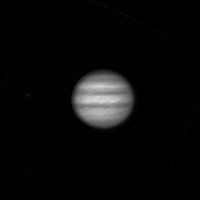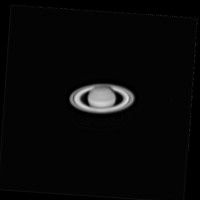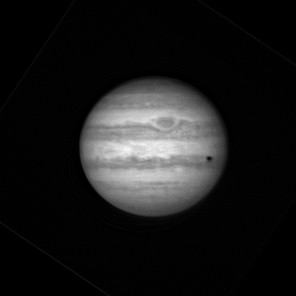The last two nights were the first planetary tests of my ‘new’ Point Grey solar system camera. Up till now I have only used it to image the Sun through the H-Alpha telescope. Thursday night was a shakedown run to make sure all the correct camera drivers and software were installed and to see if I could find a planet sized target with the camera’s small field of view. I did not have any problems and the end-to-end ‘process’ worked fine but the images produced by the camera were very small. It also became very obvious that I really missed focus.

|

|
So last night I added a x2 Barlow to the mix. It made finding the planet a little more difficult but the image size is now large enough to work with. This image of Jupiter is the best 5,000 frames of a 10,000 frame video capture through the x2 Barlow. The dark spot visible near the right edge of the planet is the shadow cast by the Galilean moon Io. The moon has not left the disk of the planet and as such is in the image but I cannot reliably pick it out. The planet is displayed in the traditional orientation with south at the top. Unfortunately, clouds moved in before Saturn rose above the tree line so I was not able to include it in last night’s test.

|
This is also the first time I have used Firecapture to record the video stream. Firecapture is free software that supports many machine vision cameras and is a very popular package for solar system imagers.
I consider last night’s test a success and will, for now, use that configuration as my standard for planetary imaging. The next step is to integrate a filter wheel and RGB filters to add color to the images.